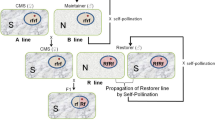Abstract
Advantages and disadvantages in using functional male sterility (positional sterile — ps, positional sterile 2 — ps 2, and excerted stigma — ex) in tomato hybrid seed production and attempts to elaborate systems for their more efficacious use in breeding were discussed in this review. It was concluded that the application of one of these types of sterility, (ps 2) in practice, although in a limited number of countries, showed the functional male sterility in tomato was a potential not to be underestimated in developing approaches that aimed at reducting the time and cost associated with hybrid seed production.
Similar content being viewed by others
References
Atanassova B. 1991. Linkage studies of the “positional sterility-2” mutant in tomato. J. Genetics & Breeding 45: 293–296.
Atanassova B. 1999. Functional male sterility (ps 2) in tomato (Lycopersicon esculentum Mill.) and its application in breeding and hybrid seed production. Euphytica, 107: 13–21.
Atanassova B., Georgiev, Hr. 1986. Investigation of tomato male sterile lines in relation to hybrid seed production. Acta Horticulturae 190: 553–557.
Atanassova B., Antcheva M., Markova M., E. Molle E. 1993. Attempt to map loci contributing to low level stigma character in tomato on chromosome 2 using isozyme marker. Proc of the XIIth Eucarpia Meeting on tomato genetics and breeding, Plovdiv, July, 27, 31: 101–105.
Dorossiev L. 1970. A new long-style mutant in the tomato variety Rutgers. Compt. Rend. Acad. Sci. Agric. Bulg., 3: 15–18.
Dorossiev L. 1976. Use of mutant forms in the development of lines for tomato hybrid seed production. Proc. “Experimental mutagenesis in plants”. Varna, October 14, 17: 370–375.
Georgiev Hr. 1991. Heterosis in tomato breeding. In “Genetic improvement of tomato”, ed. Prof. Kalloo, Springer-Verlag: 83–98.
Georgiev Hr., Atanassova, B. 1977. Manifestation of exserted stigma in F1 tomato hybrids. Genet. and Plant Breed., 10, 4: 266–271. (in Bulgarian)
Georgiev Hr., Atanassova B. 1981. Positional male sterile line tomatoes ps 2 with a low level stigma. Compt. Rend. Acad. Bulg. Sci., 34: 423–424.
Gorman S.W., S. McCormick 1997. Male sterility in tomato. Crit. Rev. Plant. Sci., 16 1: 31–53.
Honma S., Bucovac M.J. 1966. Inheritance of gibberellin induced heterostyly in tomato. Euphytica 15: 362–364.
Kaul M.L.H. 1987. Male sterility in higher plants. Monograph of Theoret. and Appl. Genet., Springer-Verlag 1005 pp.
Larson R.E., Paur S. 1948. The description and the inheritance of a functional sterile flower mutant in tomato and its probable value in hybrid tomato seed production. J. Am. Soc. Hort. Sci.: 355–364.
Nickeson R.L. 1957. Selection for combining ability in a male sterile tomato line having two recessive seedling genes. Diss. Abstr., 17, Publ. No. 22, 471: 1876.
Oryol L.I., Zhakova M.A. 1977. The mechanism of anther dehiscence of tomato Lycopersicon esculentum Mill (Solanaceae). Bot. J., LXII, 12: 1720–1730. (in Russian).
Philouze J. 1978. Percentage of selfing in a female ps 2 line used for the production of hybrid seed. Rep. TGC, 28: 13–15.
Rick C.M. 1945. Field identification of genetically male sterile tomato plants to use in producing F1 tomato seeds. Proc. Am. Soc. Hort. Sci., 46: 277–283.
Rick C.M., Robinson J. 1951. Inherited defects of floral structure affecting fruitfulness in Lycopersicon esculentum. Am. J. Bot. 38: 639–652.
Sawhney V.K. 1994. Genetic male sterility in tomato and its manipulation in breeding. In “Genetic control of self-incompatibility and reproductive development in flowering plants”, eds. E. G. Williams et al., Kluwer Acad. Publ.: 443–458.
Simonov A.A. 1967. Obtaining sterile counterparts in tomato by backcrossing. Dokl. Akad. Selskhoz. Nauk 12: 13–16. (in Russian).
Smith J.W. 1966. A new tomato root-stock seed parent. Euphytica 15: 395–404.
Singh J.P., Gill H.S., Tewari R.N. 1966. Induction of closed anther character in tomato cultivars Pusa Ruby, Money Maker and Sioux. Curr. Sci., 35: 292
Stevens M.A., C.M. Rick C.M. 1986. Genetics and breeding. In “The tomato crop”. Ed. J.G. Atherton and J. Rudich, Chapman and Hall: 80–85.
Takhur M.R. 1970. Environmental and genetic control of heterostyly in tomato (Lycopersicon esculentum Mill.). Dissertation, Ohio State Univ.
Tronickova E. 1962. New type of functional male sterility in tomato. Ved. Prace Vysk. Ust. Rostl. Vyr. Praha-Ruzine, 6: 29–39 (in Czech).
Author information
Authors and Affiliations
Rights and permissions
About this article
Cite this article
Atanassova, B. Functional male sterility in tomato (Lycopersicon esculentum Mill.) and its application in hybrid seed production. Acta Physiol Plant 22, 221–225 (2000). https://doi.org/10.1007/s11738-000-0015-4
Issue Date:
DOI: https://doi.org/10.1007/s11738-000-0015-4




